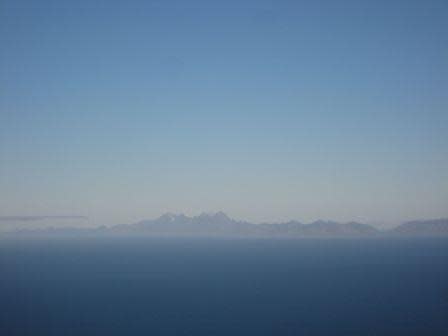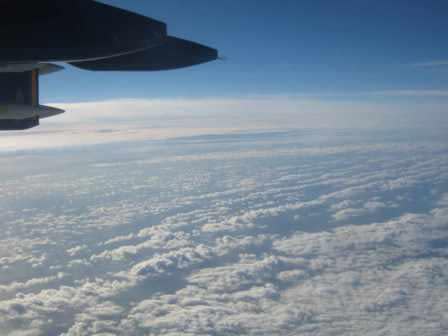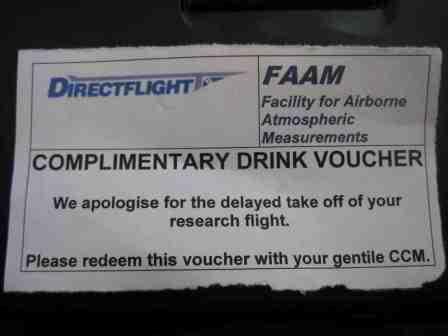Arctic Methane: Going with the flow
by Dr Jennifer Muller, University of Manchester
Sunday 22nd September.
Svalbard in the distance, as the ARA flies off its west coast. (Photo credit: Jennifer Muller)
It is good to not expect everything to go according to plan. Last Sunday (22nd September), the plan had been to head up North and fly to Svalbard (~78 ?N), land and refuel at Longyearbyen, and then sample and do more science in the Svalbard area, before heading back to Kiruna. But it was not meant to be exactly that way. The wind speed had picked up at Longyearbyen, above the threshold which would make it unsafe for the BAe-146 to take off from there. So the plans were changed in the morning, hours before the flight was supposed to take off, but then even these plans turned out not feasible either, and finally with some resolute decisions by the mission scientists John Pyle and Keith Bower, and with 1 3/4 hours delay, we left Kiruna. Instead of the two flights we were only going to have a single flight, and still achieve the key objective: sampling air near Svalbard that been transported there from Russia, i.e. sampling long-range transport of methane.
As we still needed to go as far north as Svalbard to measure these air masses advected into this part of the Arctic, and get back to Kiruna in one flight, we headed out North at high altitude (because flying low uses more fuel). Before reaching Bear Island, we descended down to lower level at 73 ?N, and then surveyed different altitudes by “saw-toothing”. This basically is making the shape of the tooth on a saw, meaning going up and down vertically in the atmosphere; for us this was between 1000 feet and minimum safe altitude, whilst travelling horizontally northwards to Svalbard. Saw-tooths are useful when trying to find the altitude of a particular aerosol and pollutant layer in the atmosphere. The models had forecasted that we would find such a layer south of Svalbard, but the enhancements in methane concentrations we measured were on the smallish side. Coming up west of Svalbard, we stayed low over the ocean, which was a little choppy, before turning around at 78 ?N and heading back at high altitude to Kiruna.
Broken up cloud streets - interesting, even to a chemist! (Photo credit: Jennifer Muller)
We went up north to measure methane that had been transported there from further east, and we did indeed sample some of that (so, success!) but there was also a whole lot of cloud around on Sunday. And in the way the saying goes “If life gives you lemons, make lemonade”, I would say Sunday was a case of “If life gives you clouds, measure clouds”. Graeme Nott from FAAM ran the core cloud instruments on the flight (i.e. cloud physics measurements, such as e.g. cloud droplet or ice number, size and type) and at some point he had an interesting conversation with Mission 1 Keith Bower over the intercom, all about bullet rosette ice crystals, and out of focus imaged ice crystals which look like donuts on the display. Always something new to learn! We also flew through some very wispy, thin ice cloud which was not obvious by looking out of the window, and only Graeme could tell us whether we were in-cloud or out-of-cloud.
Complimentary drinks voucher, to keep everyone sweet while their flight was delayed by nearly two hours.
Although my research interests are atmospheric trace gases, such as methane, I couldn’t help to thoroughly enjoy this flight for the myriad of clouds we saw. Yes, sometimes you get what you think you don’t want, and you just have to go with the flow, enjoy and make the best of it. This is also what St?phane Bauguitte from FAAM did, who creatively used the flight delay in the morning to make and distribute some tongue in cheek “Complimentary drinks vouchers”. Yet with what we saw and measured, as well as the delicious Swedish cakes, courtesy of the flight deck, there was enough to keep us scientists sweet and happy during this flight.
Follow Scientific American on Twitter @SciAm and @SciamBlogs. Visit ScientificAmerican.com for the latest in science, health and technology news.
© 2013 ScientificAmerican.com. All rights reserved.





